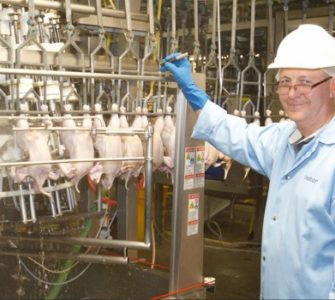Tips for ensuring best field vaccination results with Poulvac® ST or Poulvac® E. coli
An interview with Lloyd Keck, DVM, ACPV
Consulting veterinarian
Q: Why spray vaccinate chicks for Salmonella or Escherichia coli on day of placement at the farm instead of vaccinating at the hatchery?
LK: It’s a matter of logistics. Not all hatchery customers want chicks vaccinated against some diseases, and that sometimes includes Salmonella and E. coli. Segregating chicks for different customers at the hatchery, especially primary breeder hatcheries, can be difficult. Field vaccination helps ensure chicks at the hatchery and in the field are vaccinated as intended.
Q: What equipment is needed for spray field vaccination?
LK: For either Poulvac® ST or Poulvac® E. coli, you’ll need a 1- or 2-gallon pump-up sprayer, 1 liter (1 quart) of distilled water per every 5,000 chicks, 2 or 3 capfuls of Aviblue dye (or enough dye to make sure it can easily be seen on chicks) and the vaccine you’re going to administer.
Q: Does field spray vaccination require a lot of personnel?
LK: Not really. I recommend three to four people — one to spray while the others unload chicks and place them in the house.
Q: How are the vaccines mixed?
LK: With either vaccine, start by wearing clean, disposable gloves. Add the distilled water to your spray container and then add the blue dye. Next half fill the vaccine vial with cool, distilled water, shake the vial until the vaccine has dissolved, then pour the contents into the spray container. Put a bit more distilled water into the vial and shake again to rinse it. Then empty that too into the spray container.
Q: Do you have any tips for sprayer use?
LK: Be sure to pump the sprayer enough to provide adequate pressure. When pressure starts to drop, pump the sprayer again. Adjust the nozzle so your spray pattern is several inches wide.
Q: Should chicks be sprayed as soon as they are delivered to the farm?
LK: Yes, you’ll want to start as soon as chick boxes are unstacked and set on bedding in the house, along feed lines. It’s easier to make sure all chicks get sprayed and that coverage is uniform if they’re still in boxes.
Q: Is there any spray pattern that should be used?
LK: Use a back-and-forth motion — a Z pattern. You should be dispensing about 20 ml per chick box, which takes about 4 seconds. Keep the nozzle tip 2 feet above chicks.
Q: How can you be sure all chicks receive the vaccine?
LK: Simply take time to observe and make sure all chicks are marked with the blue dye. They’ll take in the vaccine by preening. Good organization and careful attention to detail will give you the best results.
Q: What should you do if you find some chicks weren’t sprayed? Can they be sprayed again?
LK: If careful attention is paid to spray pressure, volume and pattern, it’s unlikely chicks will be missed, but if any are, you can respray.
Q: Can birds be tipped out of their boxes immediately after spraying?
LK: Wait at least 10 to 15 minutes. This gives chicks time to preen off each other’s feathers. Unloading chicks can take 30 minutes or more. By the time the last boxes are being unloaded and sprayed, it’s time to start tipping chicks out of the first boxes that were placed in the house.
Q: Does the sprayer require disinfection after use?
LK: Yes, it should be washed and disinfected. After disinfection, be sure to rinse the sprayer three times with distilled water to remove any residual disinfectant, then set it out to dry.
All trademarks are the property of Zoetis Services LLC or a related company or a licensor unless otherwise noted.
TOOLBOX, Issue 12
Toolbox is a series of interviews with veterinarians and other technical specialists about their experiences managing antimicrobials, vaccines and other tools for poultry health. It is produced by the editors of Poultry Health Today on behalf of the US Poultry Business of Zoetis.
BIO-00076R1
May 2022
Posted on September 12, 2019














